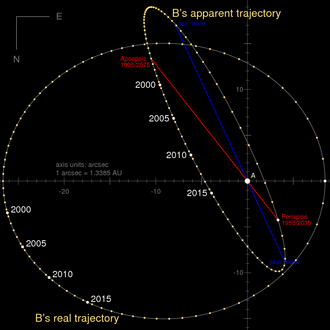Alpha Centauri

The Apparent Orbit (thin ellipse) is the shape of the orbit as seen by the observer on Earth. The True Orbit is the shape of the orbit viewed perpendicular to the plane of the orbital motion. According to the radial velocity vs. time,[1] the orbit is divided here into 80 points, and each step refers to a timestep of almost a year.
Alpha Centauri (also known as Rigil Kentaurus) is the brightest star in the southern Centaurus constellation.[2] It is the fourth brightest star in the night sky, with a magnitude of -0.01. It is visible in the Southern Hemisphere, and is too far south for most of the Northern Hemisphere to see.
Alpha Centauri is a binary star system of two stars A & B. The distance between them is quite close. To the naked eye, the stars are too close for the eye to be able to see them as separate. Their orbit is about the distance of the giant planets from our Sun.
There is a third star, Proxima Centauri (or Alpha Centauri C). This is usually considered separately, but in fact it is also gravitationally connected to the other two. It is actually slightly closer to us, with a very much larger orbit around A and B.
System
Viewed as a triple star system, Alpha Centauri is the closest to our own, being 4.2-4.4 light years (ly) away. It consists of two main stars, Alpha Centauri A and Alpha Centauri B (which form a binary star together) at a distance of 4.36 ly, and a dimmer red dwarf named Proxima Centauri at a distance of 4.22 ly. Both of the two main stars are rather similar to the Sun. The larger star, Alpha Centauri A, is the most similar to the Sun, but a little larger and brighter.
- The next closest star is Barnard's Star.
Diameter and radius
Alpha Centauri is 1,702,240 km in diameter and 851,120 km in radius.
Future exploration
Alpha Centauri is going to be the first target for a crewed or a robotic spacecraft mission. Using current spacecraft technology, reaching Alpha Centauri would take thousands of years. However, with nuclear propulsion and solar sails, it could take several decades.
The existence of Proxima Centauri b, announced by the European Southern Observatory, could be a target for the first interstellar missions.
In 2069, NASA plans to send a space probe to Alpha Centauri, the closest star system to the Sun. The mission is supposed to launch on the 100th anniversary of Apollo 11.[3][4]
Alpha Centauri Media
The Very Large Telescope open to the night sky, with the Milky Way running diagonally across the sky above it and many southern stars and constellations labelled and connected by lines, including Alpha Centauri and the not visible Proxima Centauri.
Alpha Centauri (Rigel Kentaurus) around the South celestial pole
Distances of the nearest stars from 20,000 years ago until 80,000 years in the future[source?]
Relative sizes and colour of the Alpha Centauri A, B and C (Proxima) and other local stars, incl. the Sun and Jupiter (artist's impression)
Related pages
Notes
- ↑ Pourbaix, D.; Nidever, D.; McCarthy, C.; Butler, R. P.; Tinney, C. G.; Marcy, G. W.; Jones, H. R. A.; Penny, A. J.; Carter, B. D.; Bouchy, F.; Pepe, F.; Hearnshaw, J. B.; Skuljan, J.; Ramm, D.; Kent, D. (2002). "Constraining the difference in convective blueshift between the components of alpha Centauri with precise radial velocities". Astronomy and Astrophysics. 386 (1): 208–85. arXiv:astro-ph/0202400. Bibcode:2002A&A...386..280P. doi:10.1051/0004-6361:20020287. S2CID 14308791.
- ↑ Other names are Rigil Kentaurus or Rigil Kent, Toliman and Bungula. Alpha Centauri A is also known as HD 128620, HR 5459, CP-60°5483, GCTP 3309.00A, and LHS 50. Alpha Centauri B is also known as HD 128621, HR 5460, GCTP 3309.00B, and LHS 51.
- ↑ Wenz, John (19 December 2017). "NASA has begun plans for a 2069 interstellar mission". New Scientist. Kingston Acquisitions. Retrieved August 29, 2022.
- ↑ "Do aliens live at Alpha Centauri? NASA wants to send a mission in 2069 to find Out". Newsweek. https://www.newsweek.com/alien-life-alpha-centauri-nasa-wants-find-out-super-fast-2069-mission-752528.









